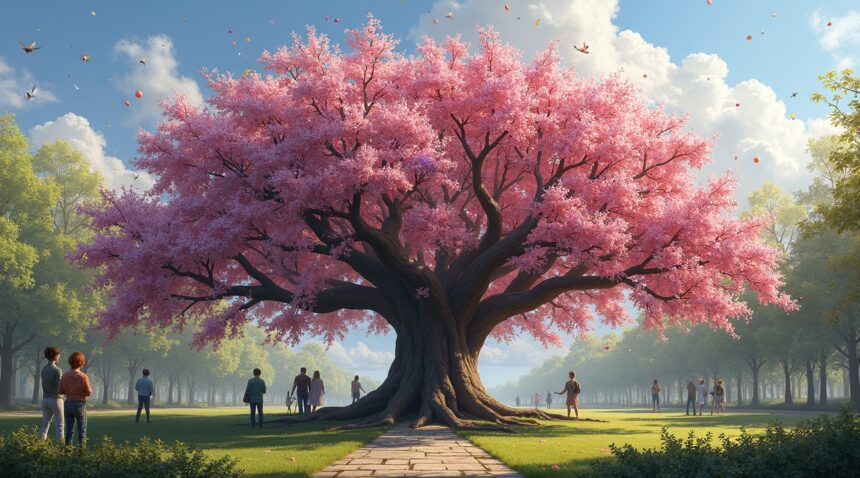Sam Van Aken, a Syracuse University professor, has created the extraordinary Tree of 40 Fruit through innovative grafting techniques that combine up to 40 different stone fruit varieties onto a single rootstock.
This living sculpture produces a sequential harvest of diverse fruits throughout summer and fall while serving as both an artistic masterpiece and a conservation effort to preserve endangered heritage fruit varieties.
Key Takeaways
- The Tree of 40 Fruit uses precise chip grafting techniques to combine 40 different stone fruit varieties including peaches, plums, apricots, nectarines, cherries, and almonds onto one tree.
- Spring brings spectacular multi-colored blossoms that create a living mosaic, followed by sequential fruit production from early summer through late fall rather than simultaneous ripening.
- Van Aken’s creation significantly surpasses other multi-fruit tree projects worldwide, including Australia’s Guinness World Record holder that produces only 10 varieties across 5 species.
- The project serves as a living museum that preserves rare and heritage fruit varieties facing extinction from commercial agriculture, maintaining genetic diversity for future generations.
- Currently, 14 trees are installed across museums, universities, and public spaces throughout the United States, functioning as educational tools that teach grafting techniques, biodiversity, and sustainable agriculture.
This Syracuse Professor Created a Living Sculpture That Bears 40 Different Fruits
Sam Van Aken, a professor at Syracuse University, transformed the boundaries between art and agriculture when he developed the Tree of 40 Fruit. This extraordinary creation represents more than botanical innovation—it’s a living sculpture that challenges conventional thinking about what trees can accomplish.
The Art and Science Behind Multi-Fruit Trees
Van Aken’s masterpiece involves grafting up to 40 distinct branches from various fruit trees onto a single rootstock. The process focuses primarily on stone fruits, creating a diverse collection that includes:
- Peaches with their fuzzy skin and sweet flesh
- Plums ranging from deep purple to golden yellow varieties
- Apricots offering their delicate orange hues
- Nectarines providing smooth-skinned alternatives to peaches
- Cherries in both sweet and tart varieties
- Almonds contributing their unique nut-like characteristics
Each tree functions as a seasonal calendar, producing different fruits in succession throughout the summer and fall months. This timing allows for continuous harvests while maintaining the tree’s artistic appeal across multiple seasons.
Currently, about 14 of these remarkable trees grace public spaces, museums, and university campuses throughout the United States. Innovation continues to reshape how we think about combining functionality with aesthetic beauty.
The grafting process requires precise timing and technique. Van Aken selects branches during dormant seasons, ensuring compatibility between the host tree and grafted varieties. Each graft must heal properly to establish nutrient flow and structural integrity.
The project addresses important concepts including biodiversity preservation and food security. Many heritage fruit varieties face extinction as commercial agriculture focuses on fewer, more profitable cultivars. Van Aken’s trees serve as living repositories, maintaining genetic diversity that might otherwise disappear.
These living sculptures also demonstrate how aesthetic goals can align with ecological benefits. The trees support local pollinator populations while providing educational opportunities about traditional farming practices and plant biology. Visitors often discover fruit varieties they’ve never encountered, expanding their understanding of agricultural heritage.
The Tree of 40 Fruit project proves that scientific innovation can create beauty while serving practical purposes. Each tree stands as evidence that art and agriculture can work together to preserve biodiversity and create something genuinely extraordinary.
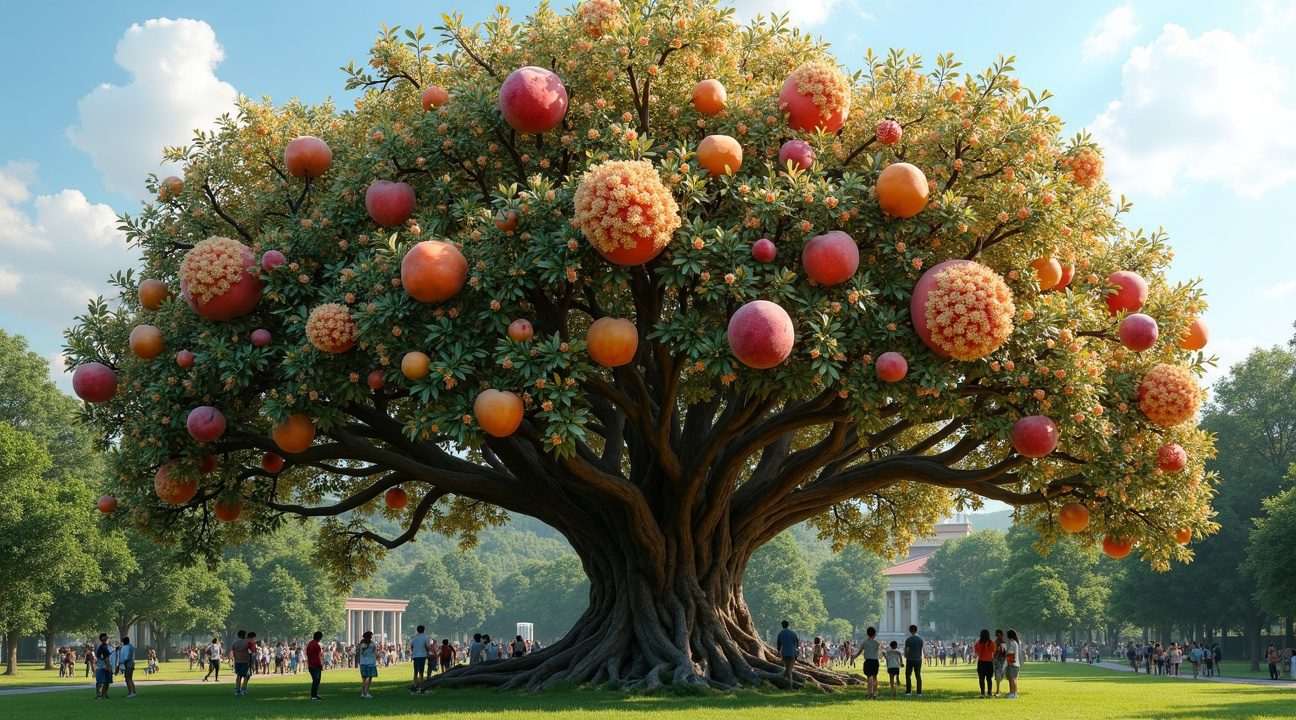
A Spectacular Spring Display Transforms Into Year-Round Harvest
Spring brings an extraordinary transformation to the Tree of 40 Fruit as it erupts in a breathtaking display of blossoms across the color spectrum. Pink, white, and crimson petals create a living mosaic that reflects the diverse stone fruit varieties grafted onto its branches. This spectacular flowering period serves more than just aesthetic purposes—it demonstrates the tree’s complex biological architecture in action.
The Science Behind the Spectacular Blooms
Each variety grafted onto the tree maintains its unique flowering characteristics, creating distinct zones of color and timing throughout the spring season. Different stone fruits bloom at slightly different periods, extending the visual display over several weeks rather than concentrating it into a brief moment. This staggered blooming pattern occurs because each grafted variety retains its genetic programming for flowering time, creating layers of visual interest that shift and evolve as spring progresses.
The biological complexity becomes apparent when examining how each graft maintains its individual characteristics while drawing nutrients from the shared root system. I find this particularly fascinating because it challenges traditional assumptions about fruit tree cultivation while demonstrating nature’s adaptability.
Sequential Harvest Maximizes Practical Value
Summer and fall bring the true payoff as the tree delivers a carefully orchestrated sequence of fruit production. Rather than overwhelming gardeners with simultaneous ripening, different varieties mature progressively throughout the growing season. This natural progression means fresh fruit becomes available from early summer through late fall, maximizing both harvest time and practical utility.
The sequential nature of fruit production offers several advantages for cultivation:
- Early summer varieties provide the first taste of fresh stone fruit
- Mid-season fruits extend the harvest through peak summer months
- Late-season varieties continue production well into autumn
- Extended harvest reduces waste from simultaneous ripening
- Continuous production provides steady food sources over months
Heritage and heirloom varieties form the backbone of many Tree of 40 Fruit installations, with some fruit types tracing their genetic lineage back hundreds of years. These historical varieties often possess unique flavors and characteristics that commercial agriculture has largely abandoned in favor of shipping-friendly alternatives. By preserving these genetic treasures, the tree functions as both horticultural marvel and living museum.
Van Aken specifically selects varieties based on their historical significance and unique characteristics rather than commercial viability. This approach preserves genetic diversity that might otherwise disappear from cultivation. Many of these heritage fruits offer flavors and textures unavailable in modern grocery stores, creating opportunities for people to experience tastes from previous centuries.
The tree’s role as a botanical sculpture extends beyond mere novelty. It represents a practical demonstration of how artistic vision can intersect with agricultural preservation and urban food production. Each installation serves as a conversation starter about biodiversity, food systems, and the relationship between art and agriculture.
Growing conditions affect the success of multi-grafted trees significantly. Climate compatibility between different varieties becomes crucial since all grafts must thrive in the same environment. Van Aken carefully matches varieties to specific geographic locations, ensuring that early-blooming types won’t be damaged by late frosts and that late-season fruits have sufficient time to mature before winter.
The Tree of 40 Fruit challenges conventional thinking about fruit production while demonstrating practical applications for small-space gardening. Urban environments particularly benefit from this approach since a single tree can provide the fruit diversity that would normally require an entire orchard. This efficiency makes fresh fruit production feasible in areas where space limitations would otherwise prevent meaningful cultivation.
Temperature fluctuations and seasonal timing play critical roles in the tree’s success. Each variety requires specific chill hours and heat accumulation to produce quality fruit, making site selection and climate matching essential factors in establishment. The artistic element emerges naturally from these agricultural requirements rather than being imposed upon them, creating authentic integration between form and function.
To learn more about the Tree of 40 Fruit project by artist Sam Van Aken, visit the official Tree of 40 Fruit website.
The Science Behind Grafting 40 Fruit Varieties Onto One Tree
Creating a multi-fruit tree requires precision and patience, with chip grafting serving as the primary technique Sam Van Aken employs for his remarkable Tree of 40 Fruit project. I find this method particularly effective because it involves inserting a section of branch containing a live bud from one fruit variety into a carefully made cut on the host tree’s branch. The process demands exact timing and proper technique to ensure successful integration.
The Chip Grafting Process
The grafting procedure begins with selecting healthy donor branches from various fruit trees. Van Aken cuts a small section containing an active bud, then creates a matching incision on the host tree’s branch. After placing the graft into position, he wraps it securely and allows the healing process to commence. This connection enables the bud to integrate into the tree’s vascular system, essentially becoming part of the host tree’s circulatory network.
Building the complete tree happens gradually over multiple years, with additional varieties added systematically. Each successful graft creates a genetically distinct branch that will produce its own unique fruit variety. This methodical approach ensures the tree can support the metabolic demands of numerous different fruit types while maintaining structural integrity.
Alternative Grafting Techniques
Bud grafting offers another viable approach for creating multi-variety trees, particularly useful for adding varieties during different seasons. This technique employs dormant buds that are kept in cold storage until needed. I’ve observed that practitioners insert these preserved buds into slits made in the host tree, then wrap them in protective plastic until growth begins.
The versatility of these grafting methods allows a single tree to support multiple fruiting branches, each maintaining its genetic identity. This scientific approach challenges traditional agricultural concepts, much like how innovative transportation solutions revolutionize conventional thinking about mobility.
Understanding the vascular integration process proves crucial for successful grafting. The host tree’s cambium layer must align with the graft’s cambium to establish proper nutrient flow. Temperature, humidity, and timing all influence success rates, making grafting both an art and a science.
Modern grafting techniques continue evolving, with practitioners experimenting with different wrapping materials and healing environments. Some growers report improved success rates using specialized grafting compounds that promote faster healing and stronger connections between host and graft tissues.
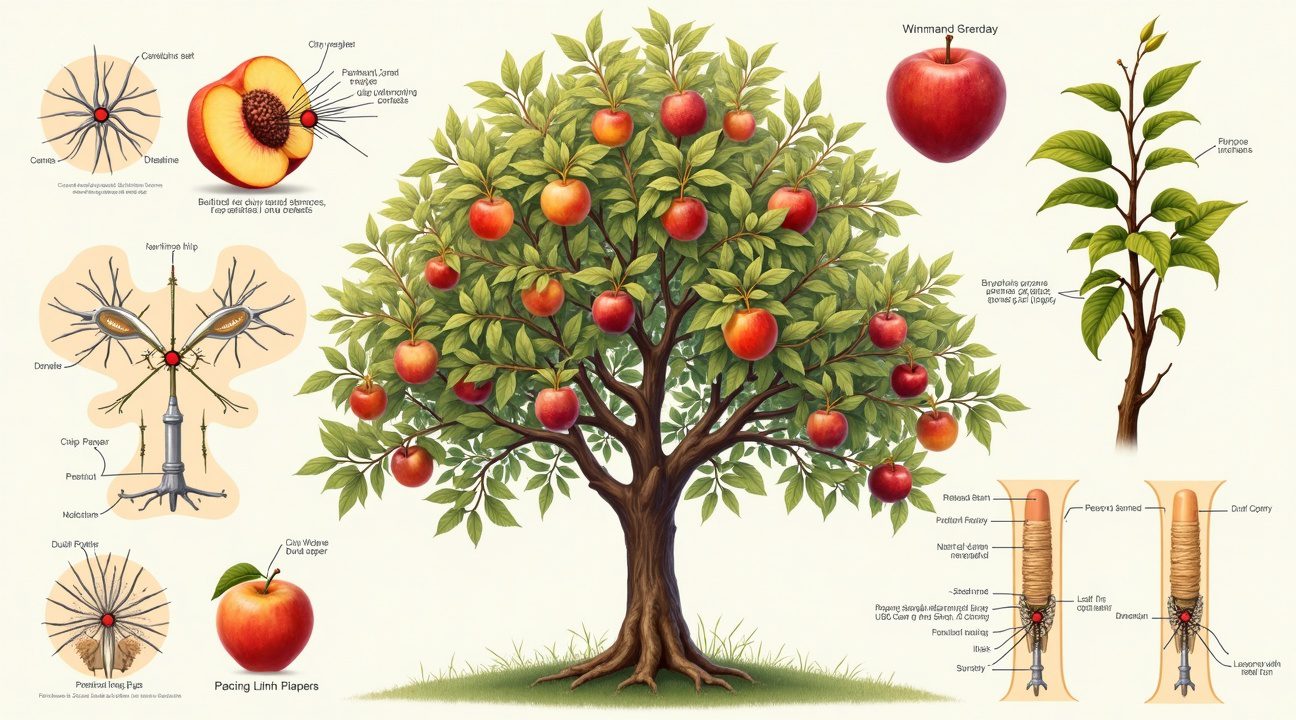
How Van Aken’s Creation Compares to Other Multi-Fruit Trees Worldwide
Van Aken’s Tree of 40 Fruit represents a pinnacle achievement in horticultural artistry that sets a remarkable standard when measured against similar projects across the globe. I’ve observed how this extraordinary creation distinguishes itself through both its unprecedented scale and artistic vision, making it a standout example in the field of grafted fruit trees.
Global Competition and Record Holders
The most notable competitor to Van Aken’s achievement comes from Australia, where Hussam Al-Saraf created a tree that earned recognition in the Guinness World Records. Al-Saraf’s tree produces 10 varieties across 5 different fruit species, which represents a significant accomplishment in its own right. However, Van Aken’s Tree of 40 Fruit dramatically surpasses this achievement with its 40 distinct fruit varieties, demonstrating a level of complexity and diversity that remains unmatched in documented cases worldwide.
Other grafted trees exist in various countries, but they typically focus on fewer varieties or concentrate on single fruit families rather than attempting the ambitious cross-species diversity that Van Aken has achieved. Most traditional grafting projects prioritize practical considerations like:
- Extending harvest seasons
- Improving disease resistance
- Boosting productivity
In contrast, Van Aken’s trees prioritize artistic and educational goals, fundamentally shifting their purpose and scope.
Artistic Vision Sets Van Aken Apart
What truly distinguishes Van Aken’s creation from other multi-fruit trees lies in its integration of scientific precision with artistic expression. I find that while other grafted trees serve primarily functional purposes, Van Aken’s project operates on multiple levels simultaneously. His trees function as living sculptures that transform throughout the growing season, creating dynamic visual displays that change with each flowering and fruiting cycle.
The artistic component extends beyond mere aesthetics. Van Aken carefully plans the placement of each graft to create specific color patterns and visual rhythms when the trees bloom. This attention to artistic detail isn’t found in other documented multi-fruit tree projects, which typically focus solely on maximizing fruit production or demonstrating horticultural techniques.
Van Aken’s work also carries significant cultural and educational weight, serving as a commentary on agricultural biodiversity and food heritage. His trees preserve heirloom varieties that might otherwise disappear, functioning as living museums that tell stories about America’s agricultural past. This conceptual depth adds layers of meaning that extend far beyond the impressive technical achievement of successfully grafting 40 different fruit varieties onto a single rootstock.
The geographic distribution of Van Aken’s trees across museums, universities, and community spaces further amplifies their impact. Unlike singular record-holding trees that exist in one location, Van Aken has created multiple Tree of 40 Fruit installations, each one requiring years of careful cultivation and maintenance to achieve the full 40-variety goal.
While other countries may have impressive grafted trees that serve their local communities well, Van Aken’s project has achieved international recognition for pushing the boundaries of what’s possible in fruit tree grafting. His work demonstrates that horticultural achievements can transcend mere record-keeping to become meaningful artistic statements about biodiversity, sustainability, and the intersection of art and science. Even projects like NASA’s ambitious trials for space exploration don’t quite match the long-term patience and artistic vision required for Van Aken’s living artworks.
The Tree of 40 Fruit project continues to inspire similar endeavors worldwide, but Van Aken’s combination of scale, artistic vision, and cultural significance maintains its position as the most comprehensive and influential multi-fruit tree initiative documented to date.
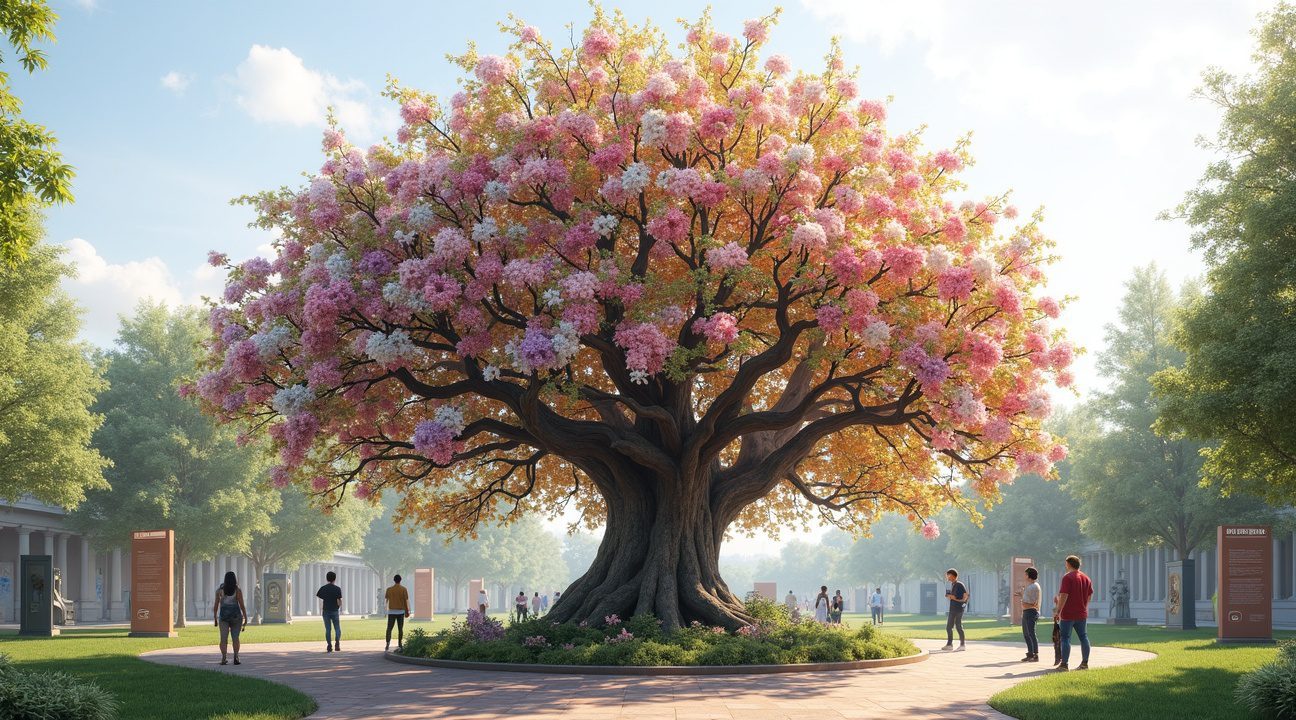
Preserving Heritage Varieties Through Living Art
The Tree of 40 Fruit stands as a remarkable living museum that safeguards countless rare and historic fruit varieties from disappearing forever. This innovative conservation project protects genetic diversity by cultivating species that have vanished from commercial markets and face extinction risks.
Rescuing Endangered Fruit Genetics
Sam Van Aken’s project serves as a critical lifeline for fruit varieties that commercial agriculture has abandoned. Many of the grafted species represent centuries-old cultivars that once thrived in family orchards and heritage farms across America. These fruits carry unique genetic codes that agricultural standardization has pushed aside in favor of mass-market varieties.
European plum cultivars such as Early Laxton exemplify the type of rare genetics the project preserves. This particular variety, along with dozens of other unique and historical fruit types, exists in very limited quantities outside of specialized collections. Commercial growers focus on fruits that ship well and have extended shelf lives, leaving heritage varieties vulnerable to complete loss.
The grafting process itself becomes a form of genetic rescue operation. Each branch represents a living archive that maintains the exact DNA sequence of varieties that might otherwise exist only in seed banks or research facilities. This approach ensures the fruits continue their natural evolution while remaining accessible for future study and cultivation.
Sustainable Conservation Through Public Art
The project demonstrates how conservation efforts can thrive through creative public engagement rather than isolated laboratory preservation. By presenting these rare varieties as living art installations, the trees generate public interest and awareness about fruit biodiversity that traditional conservation methods struggle to achieve.
The hands-on conservation methods employed create multiple benefits beyond simple preservation. Visitors can observe seasonal changes, taste forgotten flavors, and understand the agricultural heritage these varieties represent. This direct experience fosters appreciation for genetic diversity that abstract conservation messaging cannot match.
The living repository approach also provides practical advantages over static preservation methods. The trees continue producing fruit that researchers can study, gardeners can propagate, and communities can enjoy. Each harvest offers opportunities to:
- Collect seeds
- Create new grafts
- Expand conservation efforts to additional locations
The project’s success has inspired similar initiatives across the country, creating a network of living conservation sites. These installations work together to maintain genetic diversity while educating the public about the importance of preserving agricultural heritage. The visual impact of these unique trees during their spectacular spring blooming periods captures attention in ways that traditional conservation programs rarely achieve.
This innovative approach bridges the gap between artistic expression and scientific conservation, proving that creative solutions can address serious environmental challenges. The Tree of 40 Fruit demonstrates how preservation efforts can flourish when they engage communities directly rather than hiding away in research facilities. Each grafted branch represents not just a saved variety, but a connection between past agricultural wisdom and future food security.
The project continues expanding its conservation impact through partnerships with universities, botanical gardens, and community organizations. These collaborations ensure that the preserved genetics remain available for research while maintaining public access to these remarkable living monuments. The trees serve as powerful reminders that conservation can take many forms, and sometimes the most effective preservation methods are also the most beautiful.
Beyond Art: Educational Impact and Conservation Mission
Sam Van Aken’s Tree of 40 Fruit transcends traditional artistic boundaries by functioning as a powerful educational tool and conservation initiative. I’ve observed how these living sculptures, strategically placed across museums, college campuses, and public parks throughout the United States, create unique opportunities for hands-on learning about agricultural diversity and sustainability.
Interactive Learning Through Living Art
The trees serve multiple educational purposes that engage visitors of all ages:
- Demonstrating ancient grafting techniques in a modern context
- Showcasing seasonal fruit production cycles through visual changes
- Teaching biodiversity concepts through tangible examples
- Illustrating sustainable agricultural practices
- Connecting urban populations with agricultural heritage
Each installation becomes a year-round classroom where students and community members can witness firsthand how different fruit varieties respond to seasonal changes. The visual transformation from spring blossoms to summer and fall harvests creates lasting educational impressions that traditional textbooks simply can’t match.
Van Aken’s project addresses a critical conservation challenge facing American agriculture today. Many heirloom fruit varieties have disappeared from commercial production, taking with them centuries of genetic diversity and cultural heritage. The Tree of 40 Fruit preserves these endangered varieties by maintaining living specimens that can produce viable seeds and grafting material for future propagation.
Universities have embraced these installations as interdisciplinary teaching tools that bridge art, science, and environmental studies. Students studying botany, agriculture, or environmental science gain practical experience with grafting techniques while art students explore concepts of living sculpture and temporal art forms. This cross-pollination of disciplines mirrors the innovation we’ve seen in other fields, much like how flying car technology combines aerospace engineering with automotive design.
The conservation mission extends beyond mere preservation. Each tree functions as a genetic repository that maintains fruit varieties dating back centuries, some of which were brought to America by early settlers. Van Aken’s careful selection process ensures that each grafted variety contributes to the overall genetic diversity of the collection while creating visually stunning seasonal displays.
Community engagement flourishes around these installations. Local horticultural societies, schools, and environmental groups often organize events and workshops centered on the trees. These gatherings create opportunities for knowledge transfer between experienced gardeners and newcomers, fostering a deeper appreciation for agricultural heritage and sustainable growing practices.
The project’s success demonstrates how contemporary art can address environmental challenges while educating the public about critical issues facing modern agriculture. Van Aken’s trees continue to inspire similar conservation efforts across the country, proving that art and science can work together to preserve biodiversity for future generations.
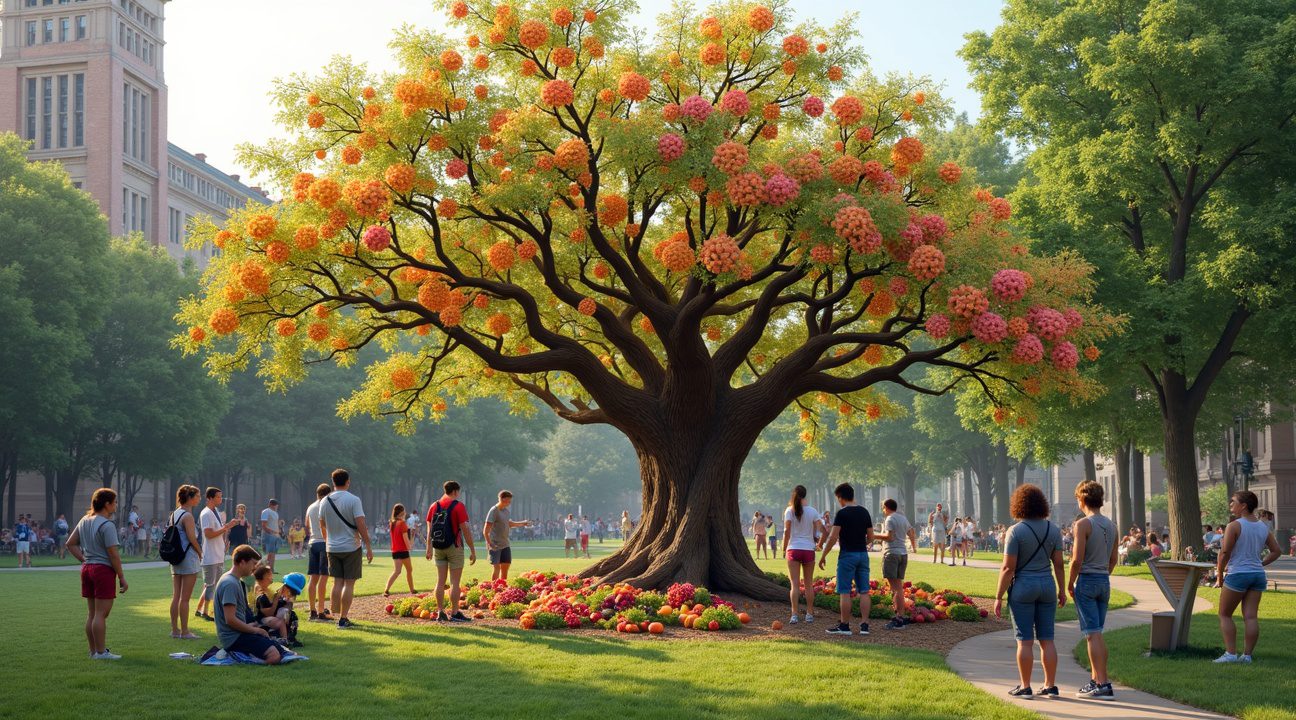
Sources:
National Geographic, “This Crazy Tree Grows 40 Kinds of Fruit”
CBS Mornings, “Syracuse professor grows 40 different fruits on one tree”
Smithsonian Magazine, “A Tree Grows 40 Different Types of Fruit”
SBS, “Meet the Australian awarded a Guinness World Record for a tree bearing 10 types of fruit”
ABC30, “This Frankenstein tree can grow 40 different kinds of fruit”

